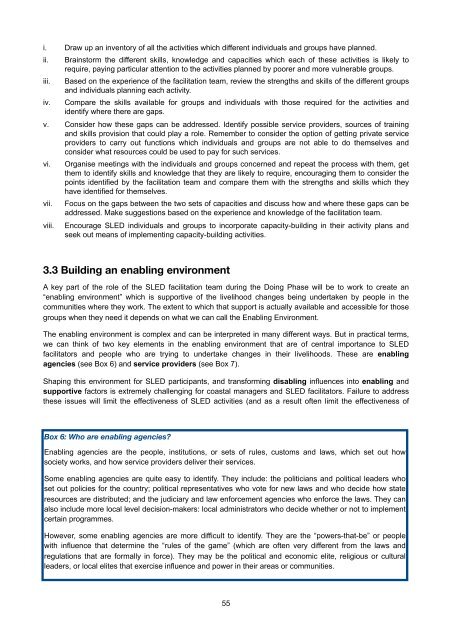Sustainable Livelihoods Enhancement and Diversification (SLED)
Sustainable Livelihoods Enhancement and Diversification (SLED)
Sustainable Livelihoods Enhancement and Diversification (SLED)
You also want an ePaper? Increase the reach of your titles
YUMPU automatically turns print PDFs into web optimized ePapers that Google loves.
i. Draw up an inventory of all the activities which different individuals <strong>and</strong> groups have planned.<br />
ii.<br />
iii.<br />
iv.<br />
Brainstorm the different skills, knowledge <strong>and</strong> capacities which each of these activities is likely to<br />
require, paying particular attention to the activities planned by poorer <strong>and</strong> more vulnerable groups.<br />
Based on the experience of the facilitation team, review the strengths <strong>and</strong> skills of the different groups<br />
<strong>and</strong> individuals planning each activity.<br />
Compare the skills available for groups <strong>and</strong> individuals with those required for the activities <strong>and</strong><br />
identify where there are gaps.<br />
v. Consider how these gaps can be addressed. Identify possible service providers, sources of training<br />
<strong>and</strong> skills provision that could play a role. Remember to consider the option of getting private service<br />
providers to carry out functions which individuals <strong>and</strong> groups are not able to do themselves <strong>and</strong><br />
consider what resources could be used to pay for such services.<br />
vi.<br />
vii.<br />
viii.<br />
Organise meetings with the individuals <strong>and</strong> groups concerned <strong>and</strong> repeat the process with them, get<br />
them to identify skills <strong>and</strong> knowledge that they are likely to require, encouraging them to consider the<br />
points identified by the facilitation team <strong>and</strong> compare them with the strengths <strong>and</strong> skills which they<br />
have identified for themselves.<br />
Focus on the gaps between the two sets of capacities <strong>and</strong> discuss how <strong>and</strong> where these gaps can be<br />
addressed. Make suggestions based on the experience <strong>and</strong> knowledge of the facilitation team.<br />
Encourage <strong>SLED</strong> individuals <strong>and</strong> groups to incorporate capacity-building in their activity plans <strong>and</strong><br />
seek out means of implementing capacity-building activities.<br />
3.3 Building an enabling environment<br />
A key part of the role of the <strong>SLED</strong> facilitation team during the Doing Phase will be to work to create an<br />
“enabling environment” which is supportive of the livelihood changes being undertaken by people in the<br />
communities where they work. The extent to which that support is actually available <strong>and</strong> accessible for those<br />
groups when they need it depends on what we can call the Enabling Environment.<br />
The enabling environment is complex <strong>and</strong> can be interpreted in many different ways. But in practical terms,<br />
we can think of two key elements in the enabling environment that are of central importance to <strong>SLED</strong><br />
facilitators <strong>and</strong> people who are trying to undertake changes in their livelihoods. These are enabling<br />
agencies (see Box 6) <strong>and</strong> service providers (see Box 7).<br />
Shaping this environment for <strong>SLED</strong> participants, <strong>and</strong> transforming disabling influences into enabling <strong>and</strong><br />
supportive factors is extremely challenging for coastal managers <strong>and</strong> <strong>SLED</strong> facilitators. Failure to address<br />
these issues will limit the effectiveness of <strong>SLED</strong> activities (<strong>and</strong> as a result often limit the effectiveness of<br />
Box 6: Who are enabling agencies?<br />
Enabling agencies are the people, institutions, or sets of rules, customs <strong>and</strong> laws, which set out how<br />
society works, <strong>and</strong> how service providers deliver their services.<br />
Some enabling agencies are quite easy to identify. They include: the politicians <strong>and</strong> political leaders who<br />
set out policies for the country; political representatives who vote for new laws <strong>and</strong> who decide how state<br />
resources are distributed; <strong>and</strong> the judiciary <strong>and</strong> law enforcement agencies who enforce the laws. They can<br />
also include more local level decision-makers: local administrators who decide whether or not to implement<br />
certain programmes.<br />
However, some enabling agencies are more difficult to identify. They are the “powers-that-be” or people<br />
with influence that determine the “rules of the game” (which are often very different from the laws <strong>and</strong><br />
regulations that are formally in force). They may be the political <strong>and</strong> economic elite, religious or cultural<br />
leaders, or local elites that exercise influence <strong>and</strong> power in their areas or communities.<br />
55
















